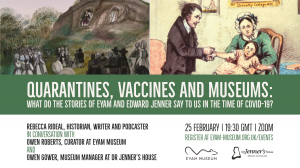Take a look at some of the below grant case studies to get inspired for your own application.
Small Grants Case Studies 2020-21
Royal Crown Derby Museum – £1,193
To purchase a digital screen enabling the medium-term realisation of a larger outreach project and the longer-term use of screen within the visitor experience.
What the Museum said about the difference the funding will make: This grant will help use and share digital content collected during ‘lockdown’ having an immediate engagement benefit as well as providing an asset for future use. This grant will support outreach projects including a live application for funding from The Space for a project to source and share digital content from the Gypsy, Roma, Traveller (GRT) communities who are collectors of Royal Crown Derby. The resulting submissions will be shared here on site using the screen.
1620s House, Leicestershire County Council – £1,170
To work with two artists to produce digital content that will be made available to schools to STEM learning inside the classroom from September 2020
Creating STEM related activity inspired by the house, its gardens and the 17th Scientific Revolution is crucial to inform the new programme of work – the project’s legacy. Inspired by this theme, Ashok Mistry will be delivering a KS2 targeted live session with pre-recorded video- focusing on dyes and the mechanics of plants. Andrew McWilliam from Chorus Theatre will also be live streaming into the classroom, using his drama skills to demonstrate how STEM curriculum links can be incorporated into his practice with KS1 pupils, inspired by the technology inside the house.
What the Museum said about the difference the funding will make: The fact that we will be creating a completely new model of delivery is really exciting. The evaluation we conduct with the schools after the delivery will help us to then produce tested and robust ideas on content, pricing and marketing. Live streaming will develop skills and knowledge in the workforce and the digital content will further the pupils learning.
The Museum of the Mercian Regiment at Nottingham Castle – £1215
The grant funded consultants to undertake a review and help create plans for a refresh of the displays in preparation for the reopening of Nottingham Castle – The Castle is closed for redevelopment and houses the main museum gallery.
What the Museum said about the difference the funding will make: This refresh would include interactives; how the objects are displayed and ensuring we get the most out of the spaces. In addition, we would like to try to display more of our collection and being able to know what is achievable is key to the success of the refresh.
Collections Access Grants:
Spalding Gentlemen’s Society – £1,000
The grant funded freezing of objects to kill pests (in textiles), volunteer training costs and purchase of specialist materials such as object handling gloves. Advice sought from Anta Hollinshead at MDEM. Project completed early 2021.
RAF Ingham Heritage Group – £807
The grant funded the purchase of specialist storage materials (boxes, paper, moth traps, id labels etc.) – advice sought from Anita Hollinshead at MDEM
Framework Knitters Museum – £400
The grant funded purchase of environmental monitoring equipment
MDEM Recovery Grants:
Museum of Timekeeping – £7,610
The grant funded relocation of an exhibition to a larger room, to free up space to create a shop (to improve income generation opportunities and change visitor flow). The grant funded purchase of display furniture, a till for the shop and relocation costs. To be completed by summer 2021.
Bassetlaw Museum – £2,803
The grant funded a project to create enhanced digital provision to encourage the return of pre-Covid audiences, attract new audiences and reach those not able to visit physically.
Daventry Museum – £9,341
The grant funded a Museum Website Revamp, to provide greater digital content, usability and engagement and to include a searchable online museum collection linked to the museum’s story themes.
Eyam Museum – £9,800
The grant funded the re-building of Eyam Museum’s offer by developing its digital presence to capitalise on media interest, grow new audiences and enable proactive public engagement and new partnerships. Funding included increased staff time to undertake the work.






